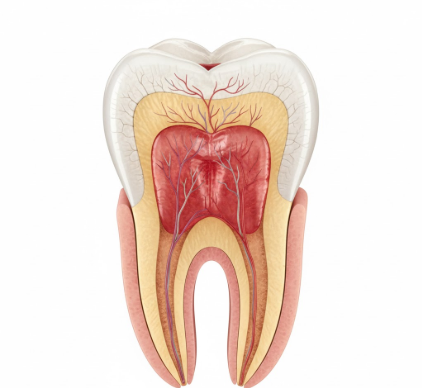Ever crunched down on an ice cube and felt that sharp, zinging sensation shoot through your tooth? Or perhaps enjoyed a hot drink only to experience a similar, albeit warmer, jolt? These aren’t just random quirks of your teeth; they’re messages from a hidden, living world deep inside – the dental pulp. While we often focus on the hard, outer enamel, the true vitality and sensory experience of a tooth reside in this remarkable inner core. Understanding the pulp is understanding what makes a tooth more than just a mineralized chewing tool; it’s what makes it a living part of your body.
The Secret Life Within: What Exactly is Tooth Pulp?
Imagine your tooth as a tiny fortress. The enamel is the super-strong outer wall, and beneath it lies a layer of dentin, still hard but more porous. At the very center of this fortress, protected by these layers, is the pulp chamber, which extends down through the roots via narrow passages called root canals. This inner sanctum houses the dental pulp, a soft, gelatinous connective tissue brimming with life.
Think of it as the tooth’s command center, its life support system, and its alarm system all rolled into one. It’s not just “the nerve” of the tooth, though nerves are a critical component. It’s a complex, dynamic environment.
Unpacking the Pulp’s Components
The pulp isn’t a homogenous blob; it’s a sophisticated blend of several key elements, each with a specific job:
- Blood Vessels: A network of tiny arteries and veins snakes through the pulp, entering and exiting through small openings at the tips of the roots (the apical foramina). These vessels are the tooth’s supply lines, delivering essential oxygen and nutrients to keep the cells within alive and functioning. They also act as waste disposal units, carrying away metabolic byproducts. This blood supply is crucial for the tooth’s health and its ability to respond to challenges.
- Nerves: These are the communicators. Nerve fibers in the pulp are primarily responsible for sensation. While they can transmit feelings of pressure or temperature to some extent, their most notable role is signaling pain. This pain response, though unpleasant, is a vital defense mechanism, alerting you when something is wrong, like decay progressing too close or an injury.
- Odontoblasts: These are arguably the star cells of the pulp, at least when it comes to tooth structure. Odontoblasts are specialized cells that line the very edge of the pulp, right up against the dentin. Their primary mission is to produce dentin. They are the architects and builders of the tooth’s main bulk, working throughout your life.
- Connective Tissue and Other Cells: The bulk of the pulp is made up of a loose connective tissue matrix, which includes fibroblasts (cells that produce collagen fibers, giving the pulp its structure), immune cells like macrophages and lymphocytes (ready to mount a defense against irritants), and undifferentiated mesenchymal cells (stem cells that hold the potential to differentiate into other cell types if needed, particularly for repair).
The dental pulp is a unique tissue, completely encased by hard dentin. This confinement, while protective, also means that when the pulp swells due to inflammation, it has nowhere to expand, which can lead to increased pressure and pain. This characteristic underlines the importance of its delicate balance.
More Than Just Sensation: The Vital Functions of Pulp
The dental pulp isn’t just a passive resident within the tooth; it actively contributes to the tooth’s health, development, and defense in several critical ways.
As mentioned, odontoblasts are the workhorses of dentin production. This isn’t a one-time job during tooth development; it’s an ongoing process:
- Primary Dentin: This is the dentin formed while the tooth is developing, before it erupts into the mouth. It forms the main shape and bulk of the tooth.
- Secondary Dentin: Once the tooth root is fully formed, odontoblasts don’t just retire. They continue to produce dentin at a much slower, more gradual pace throughout life. This secondary dentin is laid down on the pulpal surface, meaning the pulp chamber and root canals slowly get smaller over time. It’s a natural aging process for the tooth, adding a bit more protective thickness.
- Tertiary Dentin (Reparative or Reactionary Dentin): This is where the pulp shows its cleverness. If the tooth experiences an irritant, like advancing decay, a crack, or wear from grinding, the odontoblasts (or newly differentiated odontoblast-like cells) can be stimulated to lay down a localized patch of dentin right under the site of the irritation. This tertiary dentin acts like an emergency barrier, an attempt to wall off the pulp from the threat. The quality and speed of this repair depend on the intensity and duration of the stimulus.
Nutrition and Hydration
The blood vessels coursing through the pulp do more than just keep the pulp cells alive. They also provide nutrients and hydration to the dentin. While dentin is mostly mineral, it does contain organic components and microscopic tubules that benefit from this supply. A tooth with a vital, healthy pulp is generally more resilient and less brittle than a tooth that has lost its pulp.
Sensation: The Tooth’s Early Warning System
This is the function most people are familiar with. The nerves in the pulp make the tooth sensitive to various stimuli:
- Temperature: That jolt from hot coffee or ice cream is your pulp talking.
- Pressure: While some pressure sensation comes from ligaments around the tooth, the pulp can also sense direct pressure changes.
- Pain: This is the most prominent sensation. Whether it’s a sharp, fleeting pain or a dull, persistent ache, it’s the pulp’s way of shouting that something needs attention. It could be decay, a fracture, inflammation, or other issues. Ignoring dental pain is rarely a good idea.
The sensory function is crucial because it prompts you to seek care, potentially preventing a minor issue from becoming a major one.
Defense and Immunity
The pulp has a limited but important capacity to defend itself. The presence of immune cells means it can mount an inflammatory response to mild irritants or bacterial invasion. This initial response aims to neutralize the threat and initiate repair (like the formation of tertiary dentin). However, if the onslaught is too severe or prolonged, the pulp’s defense mechanisms can be overwhelmed.
The Pulp’s Journey: From Youthful Vigor to Mature Resilience
Like all living tissues, the dental pulp changes over a person’s lifetime. These changes influence its responsiveness and its overall characteristics.
In
young teeth, especially newly erupted permanent teeth, the pulp chamber is relatively large, and the pulp itself is highly cellular and vascular (rich in blood supply). This youthful pulp has a greater regenerative potential and is generally more robust in its responses. The root apices (tips) might even still be open, allowing for a very rich blood supply.
As we
age, several transformations occur. Due to the continuous, slow deposition of secondary dentin, the pulp chamber and root canals gradually become smaller and more constricted. The pulp tissue itself tends to become less cellular and more fibrous, meaning there are fewer cells and more collagen fibers. The vascularity may decrease, and the number of nerve fibers might also reduce or change in character. While these changes are natural, they can mean that an older tooth’s pulp might be slightly less capable of mounting a vigorous defense or repair response compared to a younger counterpart. It doesn’t mean the pulp isn’t vital; it just means its characteristics have evolved.
When the Inner Sanctum is Breached: Challenges to Pulp Health
Despite its protected location, the dental pulp is not invincible. Various factors can compromise its health, leading to inflammation (a condition generally known as pulpitis) and, in some cases, irreversible damage.
Common sources of irritation include:
- Dental Caries (Decay): If tooth decay progresses deep enough to penetrate the enamel and reach the dentin, bacteria and their toxins can begin to irritate the pulp. The closer the decay gets, the stronger the pulpal reaction.
- Trauma: A blow to a tooth, whether from an accident or sports injury, can damage the blood vessels and nerves supplying the pulp, even if the tooth doesn’t visibly crack or break. Sometimes this damage is immediate, other times the pulp may slowly degenerate over time.
- Cracks or Fractures: Cracks in a tooth can create pathways for bacteria and irritants to reach the pulp.
- Repeated or Extensive Dental Procedures: While necessary, sometimes multiple or very deep fillings on a tooth can, over time, cause cumulative stress to the pulp.
- Severe Gum Disease: In advanced cases, infection from the gums can sometimes reach the pulp through accessory canals or the root apex.
When irritated, the pulp typically becomes inflamed. Initially, this inflammation might be reversible, meaning if the source of irritation is removed (e.g., a small cavity is filled), the pulp can recover. However, if the irritation is severe or prolonged, the inflammation can become irreversible, leading to the eventual death (necrosis) of the pulp tissue. A non-vital pulp can no longer perform its sensory, nutritive, or defensive functions for the tooth.
It’s crucial to remember that changes in tooth sensation, like prolonged sensitivity to hot or cold, or spontaneous pain, can be signals that something is amiss deep within. These aren’t issues to ignore, as they could indicate the pulp is under stress. Regular dental check-ups play a vital role in maintaining overall oral health and can help in the early observation of conditions that might eventually affect the tooth’s inner vitality, allowing for simpler interventions.
Guarding the Fortress: Protecting Your Pulp Power
While you can’t directly see or touch your tooth pulp, you can certainly take steps to protect it by looking after the overall health of your teeth. Protecting the enamel and dentin is key to safeguarding the living center within.
Good Oral Hygiene: This is foundational. Brushing twice a day with fluoride toothpaste and flossing daily helps remove plaque, the sticky film of bacteria that causes tooth decay. By preventing cavities, or catching them when they are very small, you prevent them from ever reaching and irritating the pulp.
Regular Dental Visits: Professional cleanings remove hardened plaque (tartar) that you can’t remove at home. More importantly, dental check-ups allow for the early detection of problems like small cavities or tiny cracks before they become large enough to threaten the pulp. Early intervention is always less invasive and better for the tooth’s long-term health.
Protective Gear: If you or your children play contact sports, wearing a mouthguard is an excellent way to prevent traumatic injuries that could damage the pulp.
Mindful Eating Habits: While not directly protecting the pulp, a diet lower in sugary and acidic foods and drinks reduces the risk of enamel erosion and decay, which are primary pathways to pulp irritation.
The dental pulp, though small and hidden, is a powerhouse of biological activity. It builds, nourishes, senses, and defends your teeth. Understanding its role underscores the importance of proactive dental care. Every time you brush, floss, or visit your dentist, you’re not just polishing surfaces; you’re helping to protect this vital, living core. Our teeth are more complex and dynamic than they appear, and the pulp is the silent engine driving much of that vitality.









